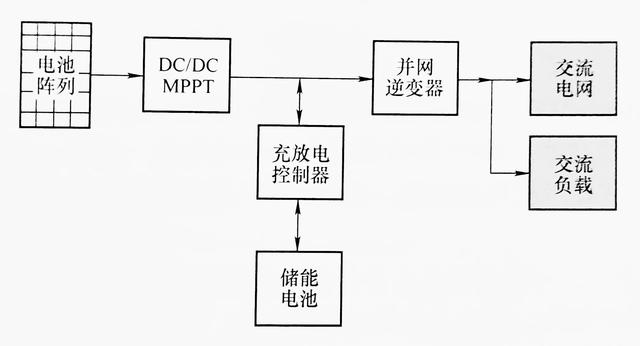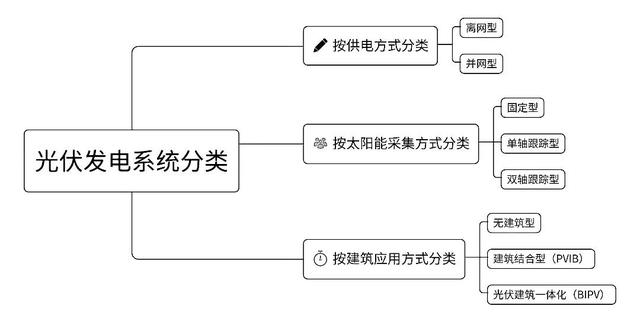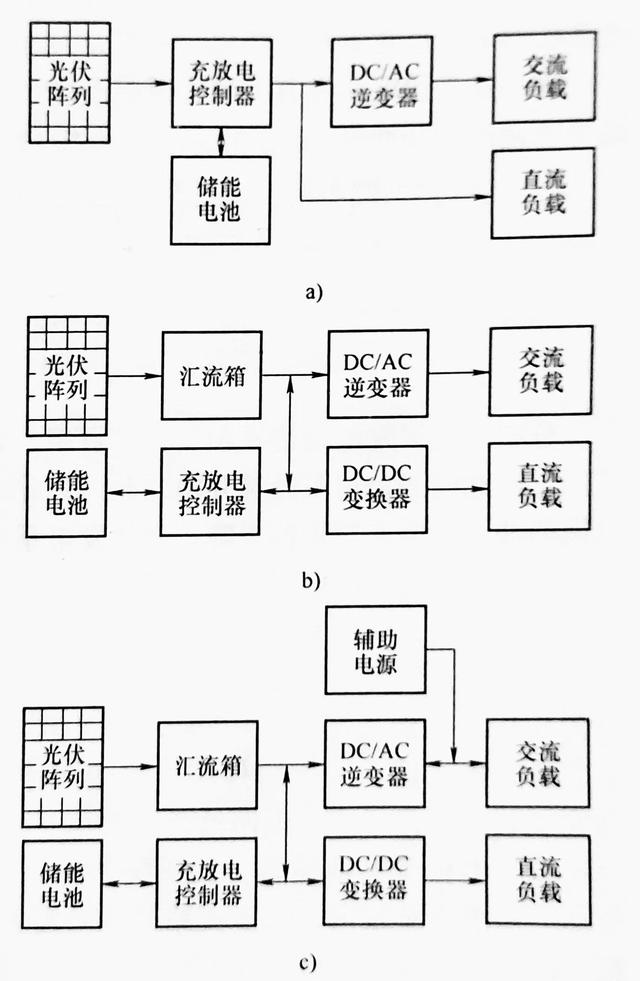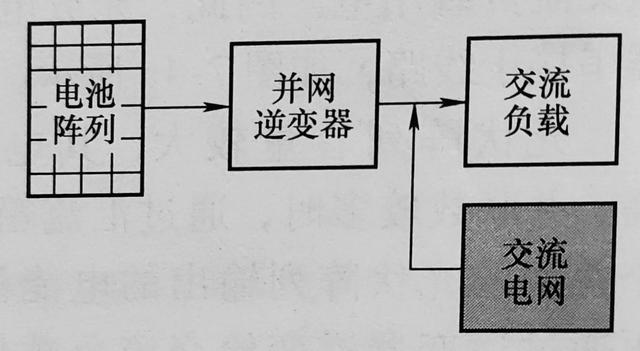Photovoltaic power generation has a very wide range of applications, as long as there is solar radiation can be applied to photovoltaic power generation. The PV module is a DC source, and its output voltage and current vary with solar radiation, temperature and load. Therefore, the application of photovoltaic power generation requires a series of other equipment such as power electronic converter to form a system with its own characteristics, which is called photovoltaic power generation system.
The photovoltaic power generation system is mainly composed of photovoltaic modules, power electronic converters, loads or power grids, as shown in Figure 1-1. According to the system requirements, various measuring equipment such as combiner box, voltmeter and ammeter, as well as energy storage, monitoring, distribution box and other equipment may also be required.
1. Classification of photovoltaic power generation system
Photovoltaic power generation systems can be classified according to power supply mode, solar energy collection mode and building application mode, as shown in Figure 1-2.
It can be divided into off grid type and grid connected type according to power supply mode; According to the solar energy collection mode, it can be divided into fixed type, single axis tracking type and double axis tracking type; According to the building application mode, it can be divided into non building type, building integrated type (full name in English: PhotoVoltaic In Building, abbreviated as PVIB) and photovoltaic building integrated type (full name in English: Building Integrated PhotoVoltaic, abbreviated as BIPV) systems.
(1) Off grid photovoltaic power generation system
The off grid photovoltaic power generation system has simple structure, small system power, flexible installation, and saves the use of fossil fuels, so it has a wide range of applications. Such as the application of solar aircraft, solar boats, solar electric vehicles and other transportation tools, and the application of solar street lamps, signal lamps, beacon billboards and other lamps. The off grid photovoltaic power generation system is applied to the living electricity in remote areas such as pastoral areas where residents are scattered in mountainous areas and the power grid cannot be connected.
The simplest off grid photovoltaic power generation system is the direct connection system, which directly supplies the DC power generated by the photovoltaic array when it is illuminated to the load. There is no energy storage equipment and power conversion equipment in the middle, and the load value can only work when there is light. This direct connection system was used in remote areas or grasslands in the early days, such as solar water pumps, but its efficiency and practicality are low. Figure 1-3 shows the application examples of solar water pump.
Generally, off grid photovoltaic power generation system is mainly composed of photovoltaic array, charge discharge controller, inverter, energy storage battery and load, as shown in Figure 1-4.
When the capacity of the photovoltaic array is large, it is necessary to add combiner box, distribution box and other equipment. The photovoltaic array converts the solar radiation energy into electrical energy, which is sent to the inverter or the inverter through the combiner box. The inverter inverts the DC power into AC power to supply power to the AC load.
When the capacity of photovoltaic array is small and the starting voltage is low, the energy is generally exchanged with the energy storage unit through the charge and discharge controller, and it is boosted to the input voltage requirements of the inverter, and then inverted for AC load power. Therefore, the charge and discharge controller is connected to the line in series, as shown in Fig. 1-4 (a).
When the photovoltaic array has a large capacity, high voltage and many parallels, the electrical energy output by multiple parallel photovoltaic arrays will be converged through the combiner box, and then the inverter will be used to supply power to the AC load, or DC/DC converter will be used to supply power to the DC load, as shown in Figure 1-4 (b).
When the solar energy is sufficient and the load electricity is surplus, the surplus electric energy generated will be stored in the battery through the charge discharge controller; When the light is poor and the power generation cannot meet the load, the charge and discharge controller releases the electrical energy stored in the battery for the load.
For the off grid photovoltaic power generation system with high load requirements on power supply reliability, in order to reduce the power loss hours of the system, if it is completely powered by the photovoltaic power generation system, the capacity of its photovoltaic modules and batteries needs to be large, resulting in excessive one-time investment costs. Therefore, according to the actual situation, the off grid photovoltaic power generation system can increase the auxiliary power supply through economic analysis to reduce the system construction cost, as shown in Figure 1-4 (c).
When encountering continuous rainy days, the photovoltaic panel power generation is insufficient, and the electric energy in the battery is exhausted, starting the auxiliary power supply (such as diesel generator) to supply power to the load can greatly improve the power supply reliability of the photovoltaic power generation system.
(2) Grid connected photovoltaic power generation system
In areas with power grids, the DC power generated by solar cells is converted from inverters to standard 50Hz AC power and connected to the power grid, thus forming a grid connected photovoltaic power generation system. In order to achieve the goal of energy conservation and emission reduction, we have made great efforts to find clean energy in recent years.
In the development and utilization of new energy, photovoltaic power generation technology has been developed and iterated in recent decades, and the technology has become very mature, and the construction cost is also declining. The development of grid connected photovoltaic power generation system is becoming more and more mature, and presents a more and more diversified trend. At present, according to the power supply mode, it is mainly divided into two types: the countercurrent type and the non countercurrent type.
The centralized photovoltaic power station has no local load or a very small proportion, and almost all the electricity generated is sent to the grid. Therefore, it is a grid connected photovoltaic power generation system with countercurrent, and its structure is shown in Figure 1-5.

In principle, the distributed photovoltaic power generation system is used spontaneously and is not controlled by the grid company, that is, it is not monitored or controlled. Therefore, the grid company restricts its grid connection and allows you to use the grid connection, but does not allow countercurrent phenomenon to prevent the impact on the grid and the decline of power quality.The distributed photovoltaic power generation system can be designed from several hundred watts to several megawatts depending on the capacity of its application object. For a small capacity grid connected system of about 10kW and below, the photovoltaic modules can be directly connected to the inverter, and the output of the inverter can be directly connected to the grid to supply power to the load, without the need for combiner boxes or distribution cabinets and other equipment. The system structure is shown in Figure 1-6. The system capacity is large, and the equipment such as combiner box and power distribution cabinet are required for current collection protection when multiple branches are connected in parallel.
In principle, the distributed photovoltaic power generation system is used spontaneously and is not controlled by the grid company, that is, it is not monitored or controlled. Therefore, the grid company restricts its grid connection and allows you to use the grid connection, but does not allow countercurrent phenomenon to prevent the impact on the grid and the decline of power quality.
The photovoltaic power generation system is connected to the power grid in parallel, and the voltage is supported by the power grid. When the photovoltaic energy is insufficient, the power grid will automatically supply the insufficient energy. When the photovoltaic energy is surplus, it is not allowed to transmit the surplus energy to the power grid. It is called a non countercurrent grid connected photovoltaic power generation system.
The distributed photovoltaic power generation system can be designed from several hundred watts to several megawatts depending on the capacity of its application object. For a small capacity grid connected system of about 10kW and below, the photovoltaic modules can be directly connected to the inverter, and the output of the inverter can be directly connected to the grid to supply power to the load, without the need for combiner boxes or distribution cabinets and other equipment. The system structure is shown in Figure 1-6. The system capacity is large, and the equipment such as combiner box and power distribution cabinet are required for current collection protection when multiple branches are connected in parallel.
Figure 1-7 shows the structure diagram of grid connected photovoltaic power generation system with energy storage and countercurrent. Combiner box, distribution cabinet and other equipment can be added as required.

The photovoltaic power generation system is affected by climate, clouds, air cleanliness, etc. Its output is a transient and unstable energy, which will impact the power grid. In order to improve the power supply quality, the distributed photovoltaic power generation system also introduces energy storage equipment, which reduces the peak shaving and valley filling effects of the photovoltaic power generation system on the grid as well as the frequency modulation effect. The former "garbage power" to the grid is converted into emergency protection energy, which improves the intelligence of the distribution grid.At present, the general distributed grid connected photovoltaic power generation system does not completely limit the countercurrent, but limits its system capacity when the system is designed. Generally, it limits the local load to less than 30%, which can ensure that the photovoltaic power generation system can be used spontaneously without current limiting measures. In actual operation, it is possible to form countercurrent in local periods, which is a grid connected official photovoltaic power generation system with countercurrent. However, due to the relatively large local load and small countercurrent energy, the impact on the power grid is very small.
As the centralized photovoltaic power station is generally located in the desert and other areas with sufficient light energy, it is far away from the city (i.e. load), and the local load is mainly household load. The demand for electricity in the morning and evening is large, while the demand in the daytime is small. The photovoltaic power generation system has sufficient light energy in the daytime and generates more electricity. Therefore, in order to absorb and introduce the energy storage system, the surplus electric energy generated during the day is stored to supply power to the load in the morning and evening, which reduces the phenomenon of power abandonment and improves the utilization rate of the photovoltaic power generation system.
Figure 1-7 shows the structure diagram of grid connected photovoltaic power generation system with energy storage and countercurrent. Combiner box, distribution cabinet and other equipment can be added as required.




